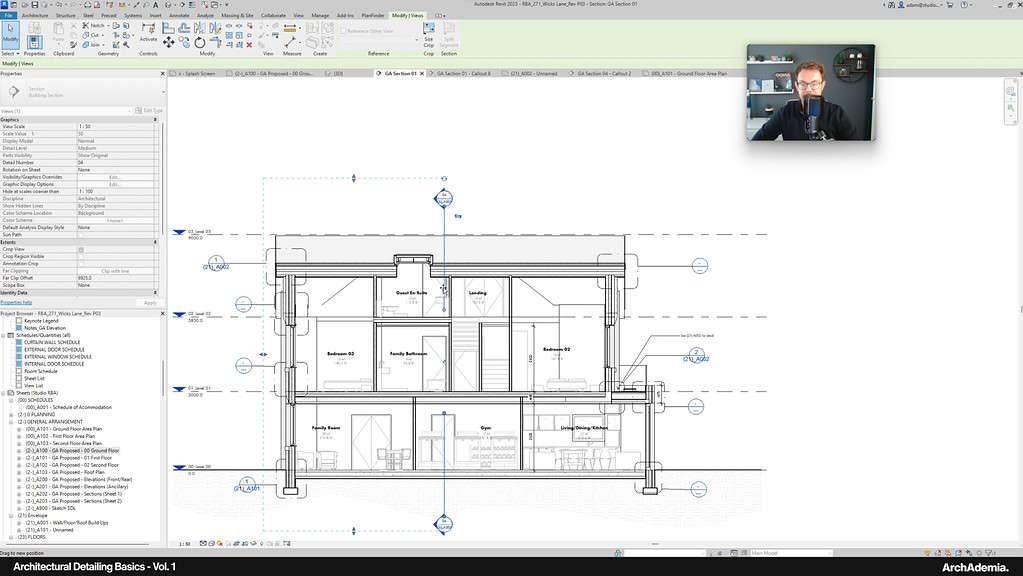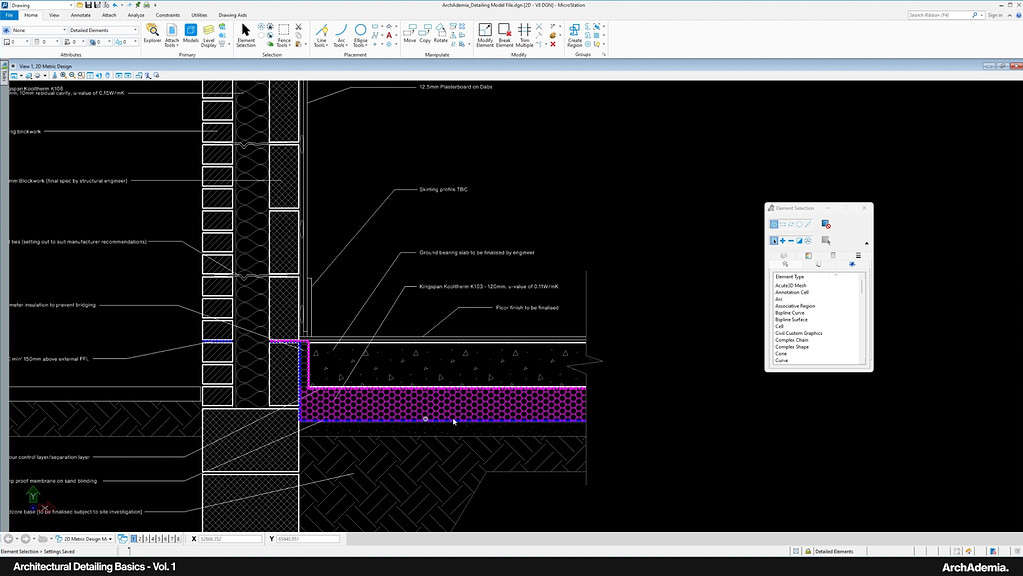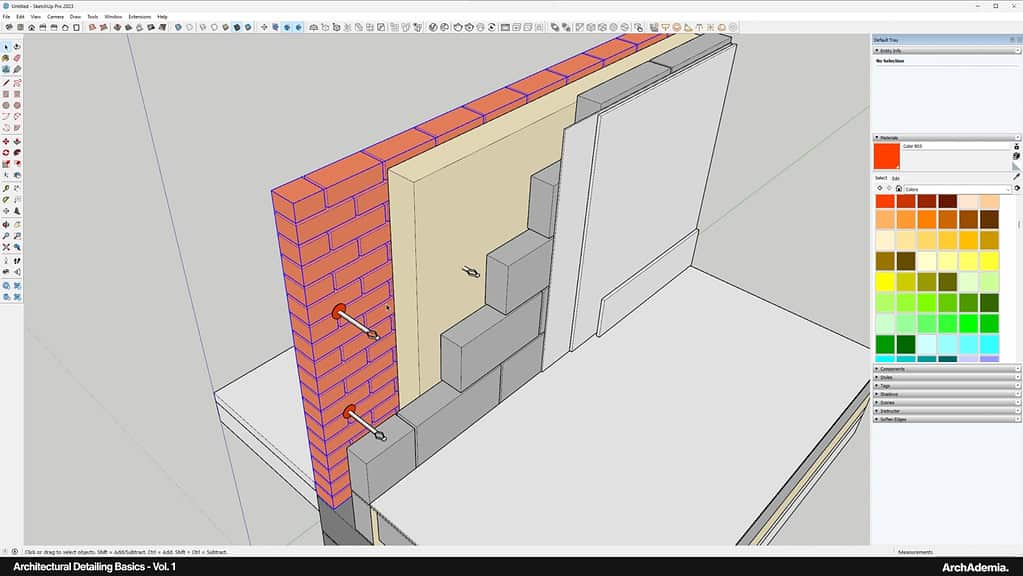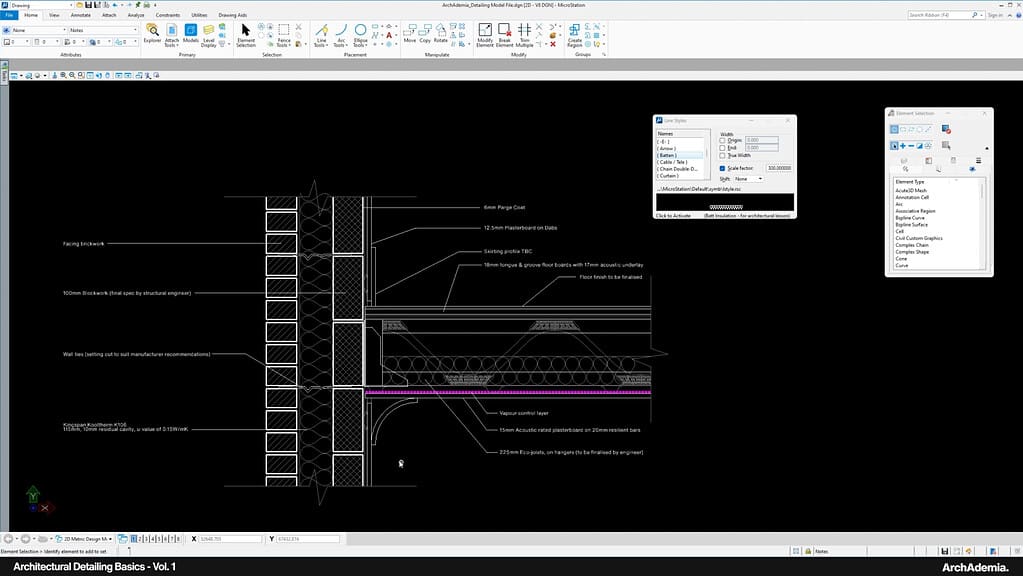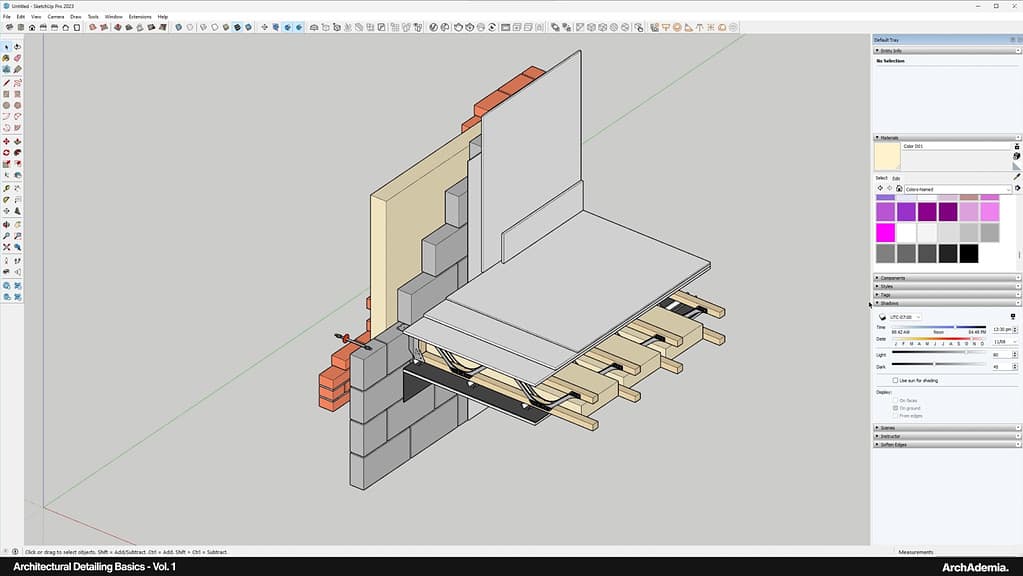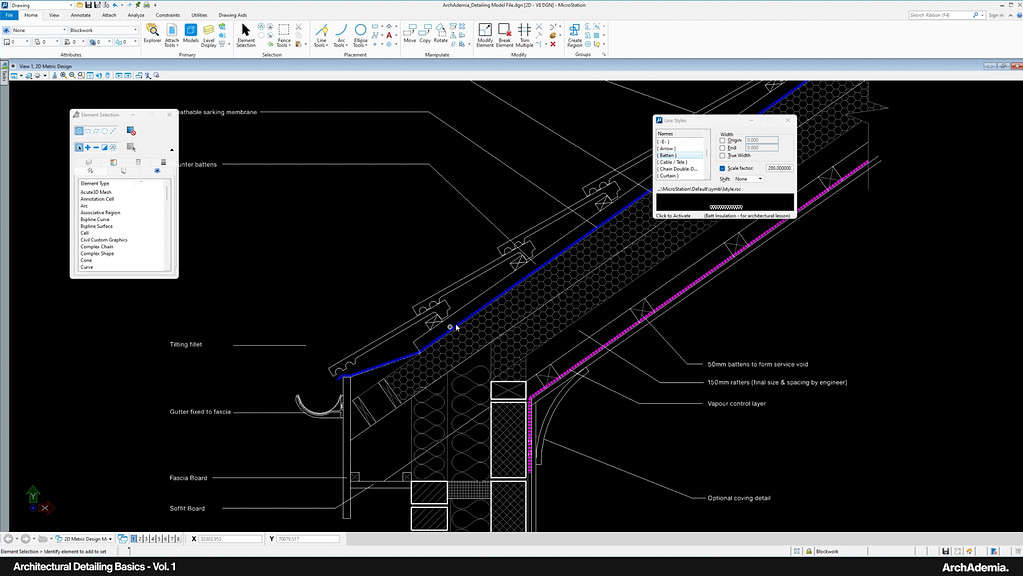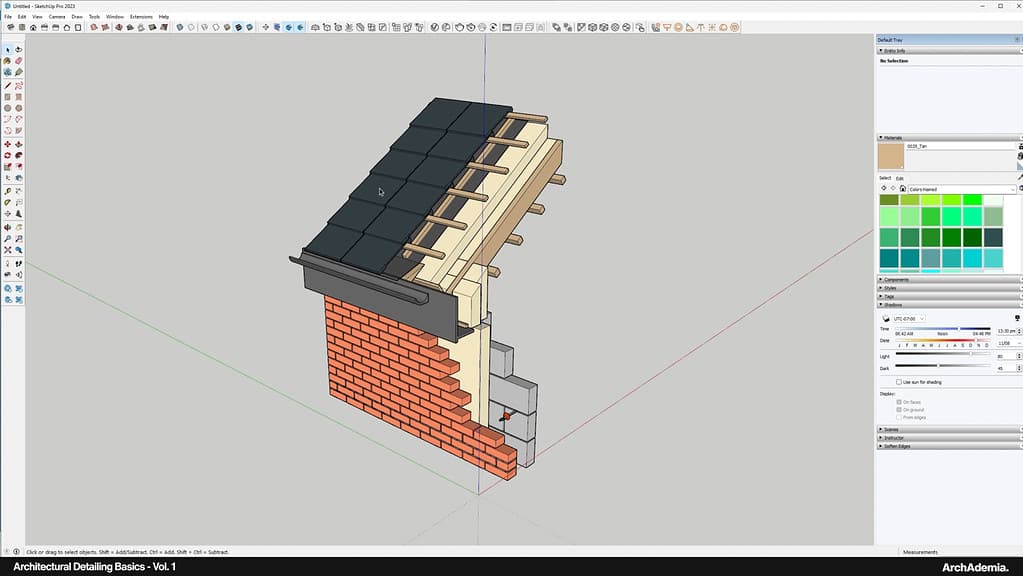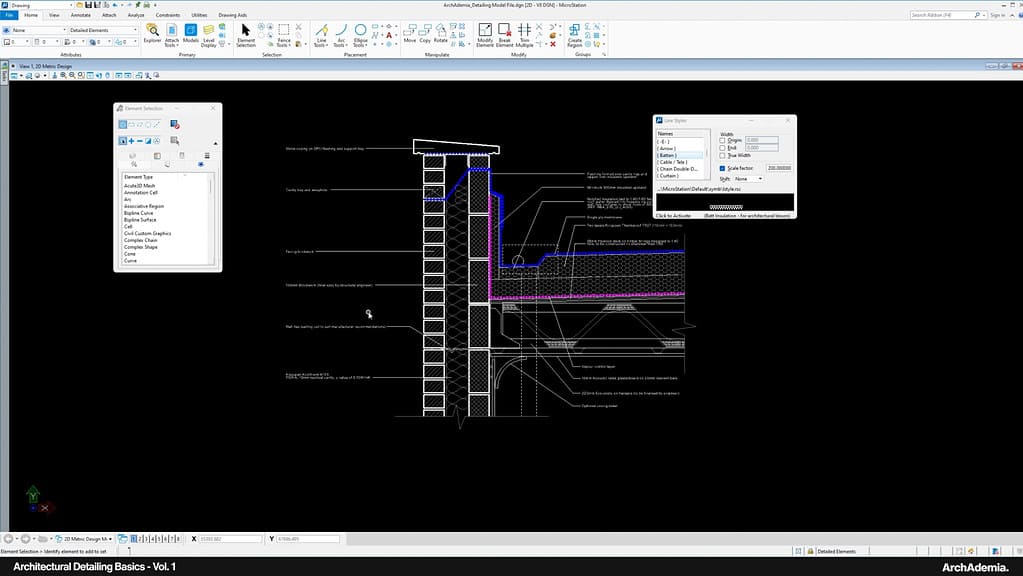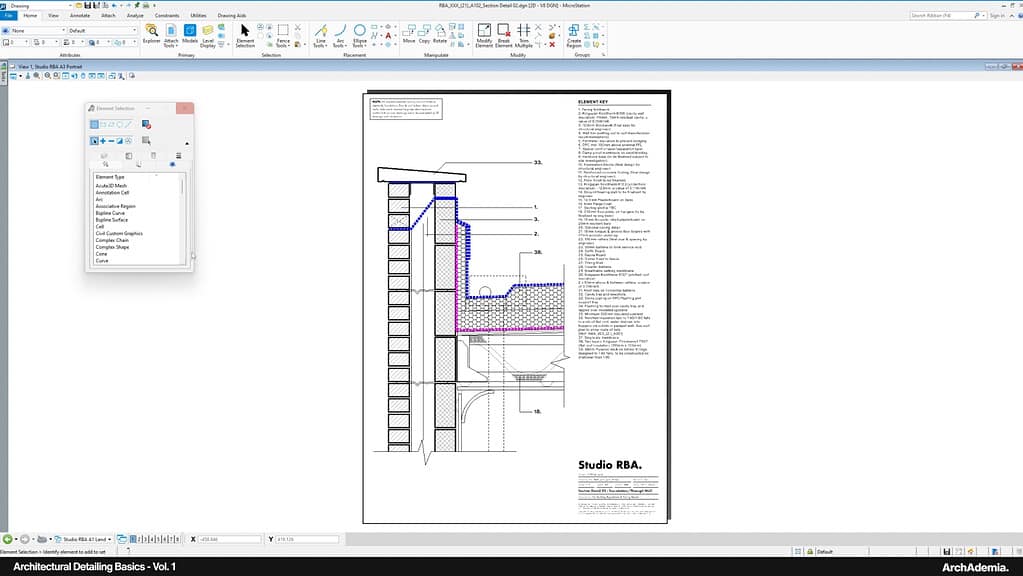Technical Design Course | Architectural Detailing Basics - Volume 1
In this 12-part course, learn the fundamentals of technical design with our first instalment of Architectural Detailing Basics. In this lesson series we cover 4 of the most common junctions you’ll come across in your career as an architect or technologist. The first volume shows you typical domestic, traditional construction details to gain a foundational knowledge of what goes into the construction of new homes.
Skill level
Intermediate
Duration
Approx. 5 hrs
Certificate
On completion
Closed Captions
English
About this course
Explore the essential principles of technical design with Architectural Detailing Basics – Volume 1, available exclusively at Archademia. This comprehensive 12-part course offers a solid grounding in construction drawing, a crucial skill for aspiring architects and technologists.
Throughout the course, you’ll dive into the world of architectural detailing, focusing on four common junctions critical to architectural projects. Whether you’re an aspiring architect or a seasoned professional looking to sharpen your skills, this course provides practical insights into the construction of new homes, covering typical domestic, traditional construction details.
From understanding the importance of detailing and section call outs to mastering the art of detailing in both 2D and 3D, each lesson is thoughtfully crafted to equip you with practical knowledge. You’ll explore foundation details, intermediate floor designs, pitched roof configurations, and flat roof structures, gaining a comprehensive understanding of these essential architectural elements.
Additionally, the course covers key topics such as element keys for consistent drawing labelling and effective drawing preparation for distribution to project teams.
To embark on this educational journey, simply sign up for an Archademia membership. With your membership, you’ll gain access to ‘Technical Design Course | Architectural Detailing Basics – Volume 1,’ empowering you with the skills and knowledge necessary to excel in the field of architecture and technical design.
Skills you'll gain
- An understanding of detailing in real world conditions
- How to specify the correct build ups for your project
- How to work with other project consultants to finalise your designs
Why ArchAdemia?
- 100% positive reviews
- Downloadable files with each course
- Access another 30+ courses
- On desktop, laptop, tablet & mobile app
Syllabus
Lesson 1 – Introduction & importance of detailing (08:00). We open the course with a detailed explanation of the importance of detailing, the impact of incorrect drawings, common mistakes to avoid, how to include other consultants within the process, avoiding scope creep and explain what the course will entail, generally.
Lesson 2 – Section Call Outs (08:50). Before arriving at a specific construction detail, you need to take the viewer on a journey as to the context of that drawing. The best approach to this starts in the ground floor plan. Create a section view, then from that section create a series of ‘call outs’, which then identify the drawing references for the details. With this knowledge any client/builder will understand the wider framing of the drawing in question. This lesson explains the steps to get to this point before we get cracking with some details!
Lesson 3 – Foundation Detail (2D) (01:02:7). The first in the detailing lessons is a lengthy one as we set the scene for the course and explain the pro tips in avoiding error, specifying the right materials and the correct approach to drawing your details in 2D. Although we use CAD in this course, the same principles would apply to Revit & Archicad, albeit with a slightly different tool set. This course isn’t about the software, but the principles of detailing in its own right.
Lesson 4 – Foundation Detail (3D) (22:55). With the first detail drawn, we take it into SketchUp and model it in 3D. The purpose for doing this is to gain a deeper understanding of the construction of this foundation, what we’re drawing and to pick up on anything that’s drawn in elevation to round off this first detail in full.
Lesson 5 – Intermediate Floor Detail (2D) (22:41). In our fifth lesson we jump back into 2D and walk through a typical intermediate floor detail and why using a particular type of joists makes for easier co-ordination with others. In addition to this we cover how to improve acoustics and vapour protection with a few simple additions to a common build up.
Lesson 6 – Intermediate Floor Detail (3D) (11:31). Bringing this detail into 3D demonstrates the importance of spacing things like joists to improve stability, strength and reduce negative impact on acoustics with a ‘bouncy floor’. You’ll also learn some additional technical design fundamentals such as, why joist spans are critical for co-ordinating with others.
Lesson 7 – Pitched Roof Detail (2D) (41:59). Moving into the two roof types, we begin with the trickier of the two; a pitched roof with insulation at rafter level. In this lesson we also explain the difference between a warm and cold roof and defend against vapour build up when using either approach.
Lesson 8 – Pitched Roof Detail (3D) (21:28). A lot is happening in roof build ups and there’s a lot of timber involved, rafters/battens/counter battens and so on. Therefore, seeing all of this in action in a 3D setting is critical in understanding what’s being drawn when back in 2D.
Lesson 9 – Flat Roof Detail (2D) (29:17). The final of the four details for this course, and another one you’ll come across quite frequently in your career, even outside of a domestic setting. Flat roofs are extremely common in all types of projects, so we felt it important to include here. We also touch on different ways of draining a flat roof to avoid future headaches!
Lesson 10 – Flat Roof Detail (3D) (20:00). We bring the detailing portion of the course home with a final 3D model, all of which can be downloaded from the course material area within the member dashboard, so you can follow along with ease or check your work back after a first attempt.
Lesson 11 – Element Keys (11:00). Now, before we wrap up the course, we explain how to adopt different labelling strategies for your drawings and one common technique is to utilise an element key that applies project wide. This key can be brought into every drawing with a consistent ‘menu’ of items specified and when a change is made it’s made throughout your entire pack of details. This lesson covers all bases on the topic.
Lesson 12 – Sheeting Up (20:05). To finish the course off, we show you our recommendation for sheeting up each detail, fit for plotting to PDF and issuing to the project team.
The importance of technical design for architects & technologists
Technical design and construction drawings are essential tools for architects, serving as a critical link between creative vision and the actual construction of buildings. These drawings provide precise measurements, specifications, and annotations that communicate crucial information to contractors and builders, ensuring that the final structure closely aligns with the architect’s original design. This clarity minimizes the potential for errors during construction, enhancing project efficiency.
Moreover, technical drawings establish a legal and contractual framework for projects by outlining materials, methods, and compliance with building codes and regulations. Architects must adhere to these codes to ensure safety, functionality, and durability in the built environment. Construction drawings also facilitate cost estimation and project management, helping with budget planning and resource allocation. In summary, technical design and construction drawings are indispensable for architects, enabling effective communication, regulatory compliance, and efficient project management. They enable architects to bring their creative visions to life while upholding the highest standards of quality and safety in construction projects.
What will you learn?

Meet your tutor - Adam Morgan | Architectural Director | Studio RBA
Hi, I’m Adam. I am the founder and director of Studio RBA, a team of 8 architects and CGI artists in the city centre of Liverpool, UK. The office is experienced in a wide range of building types and procurement routes, successfully winning projects with contract values of up to £80 million. We work for a broad spectrum of public and private sector clients across the country. I have always had a passion for teaching aspiring and young architects. I offer support to emerging young architects through the RIBA mentoring programme and am also a visiting architectural critic and tutor for Liverpool John Moores University.
Unlimited Content & Support with an ArchAdemia Membership.
Reviews from our students.
With 1000+ active members, we must be doing something right!
Freelance Architect
"I have always enjoyed and benefitted from all the content they provide for they are very useful and explained in exceptional detail. These guys are very passionate about what they do, and it shows. Keep up the great work! "
Practice Owner
"The tutors break the most complex software down into manageable and well organised learning plans. The customer support is also exceptional, with quick responses a star feature. No hesitations in recommending this platform to anyone."
Architecture Student
"I started using ArchAdemia for their extensive and cohesive courses and my I found my work excel to levels I did not think I could achieve! Couldn’t recommend a better website for students like me. "
Freelance Architect
"If you’re an Architect or an Aspiring Architect, the ArchAdemia community is something that you want to be a part of. They teach you based on experience in the real world. That’s what I love about it."
Practice Owner
"I recently started my own practice and wanted to get inspiration for how my fee letters and other documents should be set up. I got the Architects Tool Kit, and it was fantastic. I had my products immediately via email. Would recommend."
MD of Urbanist Architecture
"What makes this platform unique is the in-depth training videos designed for real life practice. We currently incorporate it for the training of our new colleagues, which also removes the tedious process of assembling content from different sources."
Architecture Student
"I joined to learn Revit, after looking at the options I realised if you sign up as an annual member all packs and future content is included in your membership. I wanted the Revit pack alongside the course, so this was the best option for me."
FAQs
We have two forms of membership, monthly and annual. Both can be cancelled at any time with no contractual obligations. Both include all course content that exists today and any future instalments, access to our community forum and monthly bonuses. Annual members benefit from two extra perks; the ability to contact us directly anytime to help with day to day issues, often resulting in a video call support session, and free access to all downloadable resources (currently worth £300 total).
Monthly memberships are £15 per month and our annual membership is £79 paid per year. Head over to our pricing page to find out exactly what’s included with each. FYI – both memberships auto-renew.
Once you’ve created your account you’ll be taken to the members area. There, you have easy access to your account information, where you’ll receive instructions on how to cancel if you wish to do so.


